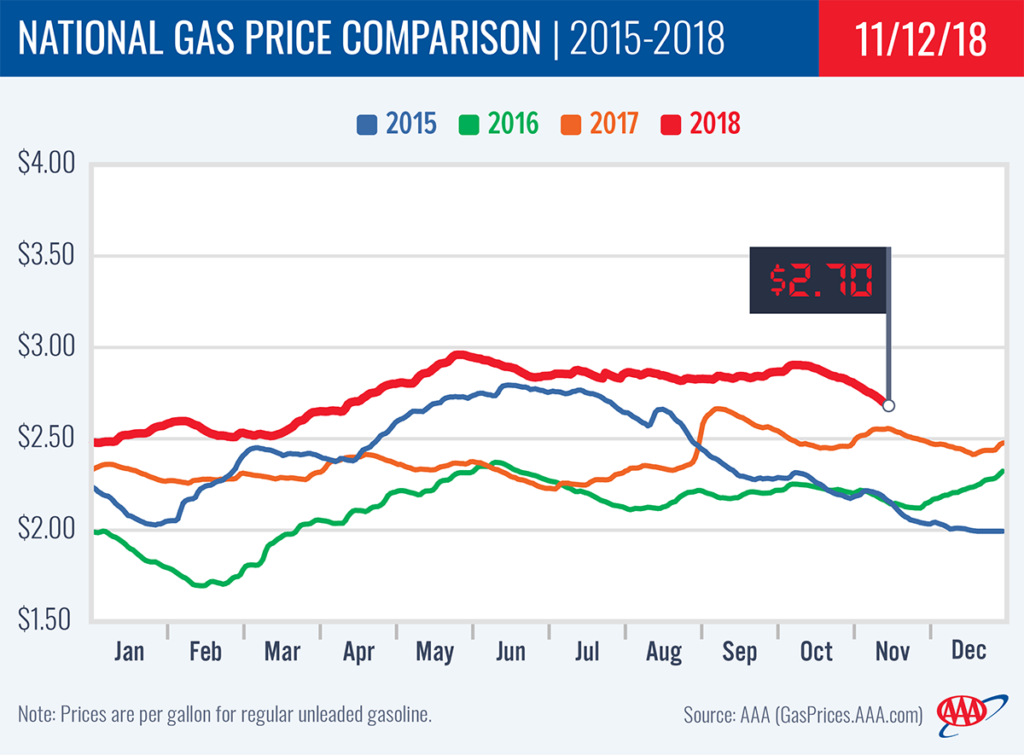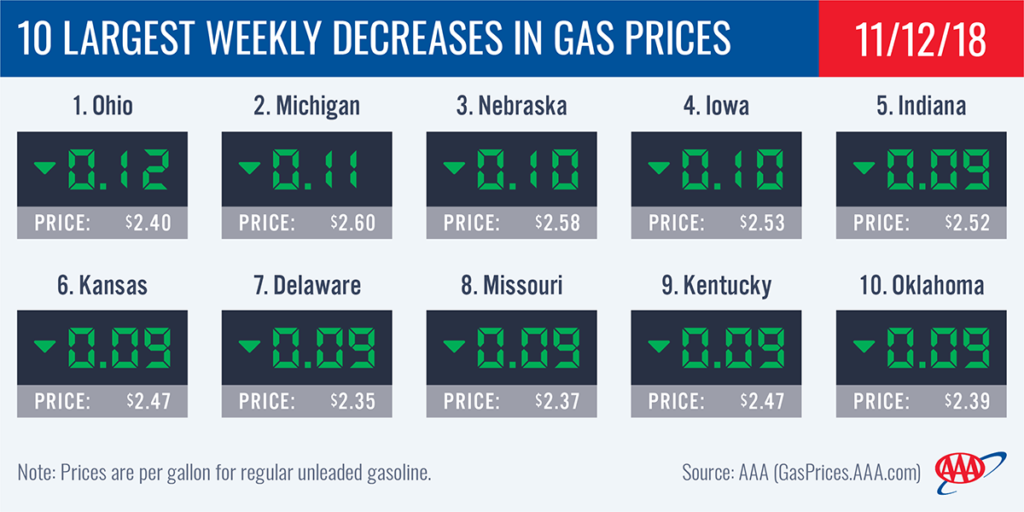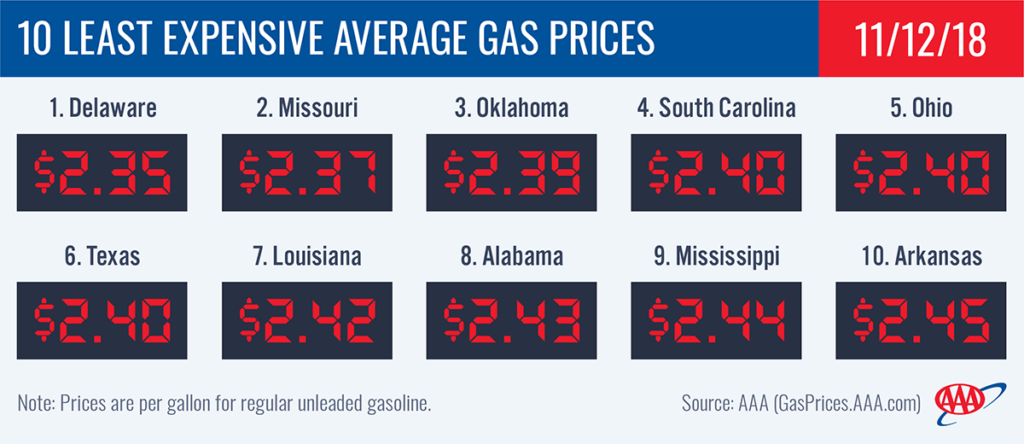State gas price averages are as much as 12-cents to a nickel cheaper a gallon on the week in more than two-thirds of the country. As demand drops and the end of refinery maintenance season wraps-up, the national gas price average is $2.70. That price is six cents less than last Monday, 21-cents less than last month and just 14-cents more than last year. In fact, the year-over-year price differential has not been this small since early January.
“Prices could plunge even lower, especially if we see a surge in gasoline production after refiners fully restart units from the fall maintenance season,” said Jeanette Casselano, AAA spokesperson. “Also driving down pump prices is the fact that crude oil is selling under $65/bbl, a rare sight this year.”
Today, 41 percent of gas stations nationwide are selling unleaded gasoline for $2.50 or less. In comparison, the majority of gas stations were selling gas for $2.51 or more at the start of summer during the Memorial Day holiday weekend.
Quick Stats
The nation’s top 10 least expensive markets are: Delaware ($2.35), Missouri ($2.37), Oklahoma ($2.39), South Carolina ($2.40), Ohio ($2.40), Texas ($2.40), Louisiana ($2.42), Alabama ($2.43), Mississippi ($2.44) and Arkansas ($2.45).
The nation’s top 10 largest weekly decreases: Ohio (-12 cents), Michigan (-11 cents), Nebraska (-10 cents), Iowa (-10 cents), Indiana (-9 cents), Kansas (-9 cents), Delaware (-9 cents), Missouri (-9 cents), Kentucky (-9 cents) and Oklahoma (-9 cents).
Great Lakes and Central
Gas prices in eight Great Lakes and Central states land on the top 10 list of states with the biggest changes, a handful with double-digit drops: Ohio (-12 cents), Michigan (-11 cents), Nebraska (-10 cents), Iowa (-10 cents), Indiana (-9 cents), Kansas (-9 cents), Missouri (-9 cents) and Kentucky (-9 cents). Gas prices are, at a minimum, a nickel cheaper in every state in the region on the week.
Only six states in the country have cheaper gas prices today as compared to a year ago. Five are Great Lakes and Central states: Illinois ($2.68), Michigan ($2.60), Indiana ($2.52), Iowa ($2.53) and Ohio ($2.40). With gas prices just pennies more than last year, these three states also might see the same trend soon: Missouri ($2.37), Nebraska ($2.58) and Wisconsin ($2.61).
The region saw a small draw of 856,000 bbl on the week, tightening gasoline stocks to a new low for the year. The last time the region saw stocks register at the 46 million bbl mark was during October 2017, according to Energy Information Administration (EIA) data. As refineries wrap-up maintenance season it is likely stocks will increase and drive prices potentially even cheaper amid declining demand.
Mid-Atlantic and Northeast
November continues to bring gas price averages under $3 for every state in the Mid-Atlantic and Northeast region. Connecticut ($2.92), New York ($2.91), Washington, D.C. ($2.88) and Pennsylvania ($2.88) have the most expensive averages. Delaware ($2.35) carries the cheapest average in the region and the country this week.
With a nine- and eight-cent decline, respectively, Delaware and Maryland, saw the largest week-over-week change in pump prices.
Despite refinery utilization down two percent to 74.5, the EIA reports that gasoline stocks remain relatively stable at 64 million bbl. Overall, stocks are at a 12 million year-over-year surplus.
South and Southeast
New Mexico ($2.65), Florida ($2.57) and Georgia ($2.56) carry the most expensive state gas price averages among all South and Southeast states. However, while these are pricey for the region, they all rank among the 25 cheapest averages in the country. This week, the following states are the cheapest in the region and rank among the top 10 least expensive in the country: Oklahoma ($2.39), South Carolina ($2.40), Texas ($2.40), Louisiana ($2.42), Alabama ($2.43), Mississippi ($2.44) and Arkansas ($2.48).
Prices are likely to drop even further as stocks built by 2.4 million bbl on the week. In addition, refinery utilization held steady at 97 percent. Total inventories sit at nearly 83 million bbl, which are about 5 million bbl more than this time last year and will continue to contribute towards driving gas prices cheaper.
West Coast
Motorists in the West Coast region are paying some of the highest pump prices in the nation, with six of the region’s states landing on the nation’s top 10 most expensive list. Hawaii ($3.91) is the nation’s most expensive market, followed by California ($3.70), Washington ($3.47), Alaska ($3.35), Oregon ($3.29), Nevada ($3.26), and Arizona ($2.89). On the week, all prices in the region are lower. California and Oregon saw the largest drops at a nickel each.
The EIA’s weekly petroleum status report for the week ending on November 2, showed West Coast gasoline stocks grew to 27.3 million bbl. Stocks are approximately 200,000 bbl lower than at this time last year, which could cause prices to spike if there is a supply challenge in the region this week.
Rockies
Gas prices are as much as a nickel cheaper across the Rockies states on the week: Colorado (-5 cents) Montana (-4 cents), Idaho (-4 cents), Utah (-2 cents) and Wyoming (-1 cent). Despite the declines, these five states rank among the 20 most expensive in the country. Notably, motorists in Utah ($2.99) are paying under $3/gal to fill-up for the first time since mid-April
Compared to a year ago, gas price averages in the region are very expensive with four of the five states landing on the top 10 largest yearly changes: Utah (+51 cents), Idaho (+41 cents), Wyoming (+38 cents), Montana (+34 cents) and Colorado (+25 cents).
Refinery utilization decreased below 90 percent for the first time in eight weeks. However, the EIA reports that gasoline stocks built by a small 150,000 bbl on the week. Total stocks sit at 6.9 million bbl, a healthy level for this time of year.
Oil market dynamics
At the close of Friday’s formal trading session on the NYMEX, WTI decreased 48 cents to settle at $60.19. Oil prices drifted lower this week, following the release of EIA’s report that total domestic oil inventories grew by 5.8 million bbl last week. They now sit at 431.8 million bbl, which is 25.3 million bbl less than inventories last year at this time. Crude inventories have grown for seven consecutive weeks because of reduced refinery runs while the nation settles into the lower demand fall driving season. A new all-time high estimate in domestic crude production since EIA began publishing the data – 11.6 million b/d – also contributed to last week’s build in crude inventories. Moving into this week, crude prices may drop further if supply concerns remain reduced due to continued growth in inventories.
Motorists can find current gas prices along their route with the free AAA Mobile app for iPhone, iPad and Android. The app can also be used to map a route, find discounts, book a hotel and access AAA roadside assistance. Learn more at AAA.com/mobile.



